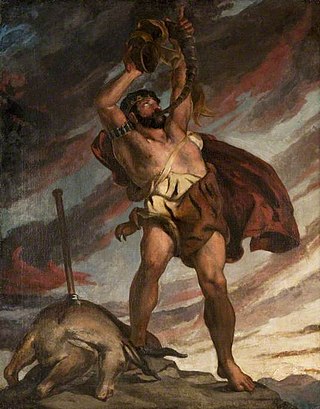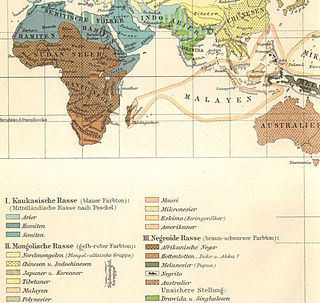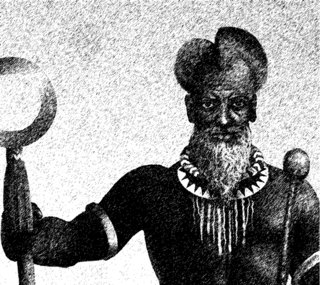Related Research Articles

Japheth is one of the three sons of Noah in the Book of Genesis, in which he plays a role in the story of Noah's drunkenness and the curse of Ham, and subsequently in the Table of Nations as the ancestor of the peoples of the Aegean Sea, Anatolia, Caucasus, Greece, and elsewhere in Eurasia. In medieval and early modern European tradition he was considered to be the progenitor of the European peoples.

Noah appears as the last of the Antediluvian patriarchs in the traditions of Abrahamic religions. His story appears in the Hebrew Bible, the Quran and Baha'i writings, and extracanonically.

Artaxerxes I was the fifth King of Kings of the Achaemenid Empire, from 465 to December 424 BC. He was the third son of Xerxes I.

Nimrod is a biblical figure mentioned in the Book of Genesis and Books of Chronicles. The son of Cush and therefore the great-grandson of Noah, Nimrod was described as a king in the land of Shinar. The Bible states that he was "a mighty hunter before the Lord [and] ... began to be mighty in the earth". Some later (non-biblical) traditions, interpreting the story of Jacob's dream in the Bible, identified Nimrod as the ruler who had commissioned the construction of the Tower of Babel or of Jacob's Ladder, and that identification led to his reputation as a king who had been rebellious against God.
Cush or Kush, according to the Hebrew Bible, was the oldest son of Ham and a grandson of Noah. He was the brother of Mizraim, Phut, and Canaan. Cush was the father of Nimrod.

Josiah or Yoshiyahu was the 16th King of Judah. According to the Hebrew Bible, he instituted major religious reforms by removing official worship of gods other than Yahweh. Until the 1990s, the biblical description of Josiah’s reforms were usually considered to be more or less accurate, but that is now heavily debated. According to the Bible, Josiah became king of the Kingdom of Judah at the age of eight, after the assassination of his father, King Amon, and reigned for 31 years, from 641/640 to 610/609 BCE.

The Kingdom of Rwanda was a Bantu kingdom in modern-day Rwanda, which grew to be ruled by a Tutsi monarchy. It was one of the oldest and the most centralized kingdoms in Central and East Africa. It was later annexed under German and Belgian colonial rule while retaining some of its autonomy. The Tutsi monarchy was abolished in 1961 after ethnic violence erupted between the Hutu and the Tutsi during the Rwandan Revolution which started in 1959. After a 1961 referendum, Rwanda became a Hutu-dominated republic and received its independence from Belgium in 1962.

In the Book of Genesis, the curse of Ham is described as a curse which was imposed upon Ham's son Canaan by the patriarch Noah. It occurs in the context of Noah's drunkenness and it is provoked by a shameful act that was perpetrated by Noah's son Ham, who "saw the nakedness of his father". The exact nature of Ham's transgression and the reason Noah cursed Canaan when Ham had sinned have been debated for over 2,000 years.
Kiga people, or Abakiga, are a Bantu ethnic group native to south western Uganda and northern Rwanda.
The Hororo or Bahororo are a Bantu-speaking ethnicity mainly residing in the north of the former Kigezi District in southwestern Uganda. In 1905, they were described by a British officer as a "quiet, inoffensive people" who owned cattle. They are made up mostly of the Hima ethnic group and the Bantu ethnic group. They reside mainly in Rujumbura in southwestern Uganda and are related to the Banyankole, Banyoro, Batooro, Songora and Tutsi peoples respectively. Rujumbura was ruled by the BeeneKirenzi sub-clan with Omukama Karegyesa as their last king. The Bahororo speak a dialect of Nkore-Kiga, Ruhororo. They are subdivided into clans that are similar to those of the kingdom of Ankole. Unlike Ankole, which was ruled by the Hinda clan, Mpororo was led by the Bashambo clan.

Hamites is the name formerly used for some Northern and Horn of Africa peoples in the context of a now-outdated model of dividing humanity into different races; this was developed originally by Europeans in support of colonialism and slavery. The term was originally borrowed from the Book of Genesis, in which it refers to the descendants of Ham, son of Noah.

Gihanga I is a Rwandan cultural hero described in oral histories as an ancient king popularly credited with establishing the ancient Kingdom of Rwanda. Gihanga descended from a line of gods Ibimanuka kings headed by Kigwa and introduced foundational elements of the African Great Lakes civilization, including fire, cattle, metalworking, hunting, woodworking, and pottery. He was described as possessing talents in leadership, technology, and spirituality. It is said that Gihanga ruled Rwanda from his palace in the now forest of Buhanga, an area that retained its forbidden and sacred status through the period of colonialism until the new government of Paul Kagame opened it to the public in 2004. No tangible evidence exists - apart from oral myths - to indicate that Gihanga lived, although many Rwandans believe that he once lived.
The Rwanda National Congress is Rwandan opposition group in exile, established in the United States on 12 December 2010. Prominent founders included Dr. Theogene Rudasingwa, Gen. Kayumba Nyamwasa, Gerald Gahima, and Patrick Karegeya. Karegeya was murdered on 31 December 2013. Rudasingwa and Gahima have since left the organization.

Ruganzu II Ndoli was Mwami of the Kingdom of Rwanda from 1510 until death in 1543. He was the son of King Ndahiro II Cyamatare and Nyirangabo-ya-Nyantaba. Ruganzu II is the most renowned king of Rwanda. He was a great warrior and was alleged to have performed miracles. His life and reign pervade many legends in the history of Rwanda. His father King Cyamatare and members of his family were brutally murdered by Nyebunga and his allies. Before dying, the king planned and executed his son's escape plan.
Kigeli II Nyamuheshera was a Mwami (King) of the Kingdom of Rwanda in the 14th century.
Yuhi wa II Gahima II was, according to tradition, Mwami of the Kingdom of Rwanda during the fifteenth century. A member of the Nyiginya dynasty, he was supposed to have reigned between 1444 and 1477.
Baalshillem II was a Phoenician King of Sidon, and the great-grandson of Baalshillem I who founded the namesake dynasty. He succeeded Baana to the throne of Sidon, and was succeeded by his son Abdashtart I. The name Baalshillem means "recompense of Baal" in Phoenician.

The 1922 regnal list of Ethiopia is an official regnal list used by the Ethiopian monarchy which names over 300 monarchs across six millennia. The list is partially inspired by older Ethiopian regnal lists and chronicles, but is notable for additional monarchs who ruled Nubia, which was known as Aethiopia in ancient times. Also included are various figures from Greek mythology and the Biblical canon who were known to be "Aethiopian", as well as figures who originated from Egyptian sources.
Ethiopis or Itiyopp'is is the name of a legendary king from Ethiopian tradition who was the inspiration behind the name of the country, Ethiopia.
According to an Ethiopian tradition, the term Ethiopia is derived from the word Ethiopis, a name of the Ethiopian king, the seventh in the ancestral lines. Metshafe Aksum or the Ethiopian Book of Aksum identifies Itiopis as the twelfth king of Ethiopia and the father of Aksumawi. The Ethiopians pronounce Ethiopia እትዮጵያ with a Sades or the sixth sound እ as in incorporate and the graph ጰ has no equivalent in English or Latin graphs. Ethiopis is believed to be the twelfth direct descendant of Adam. His father is identified as Kush, while his grandfather is known as Kam.
